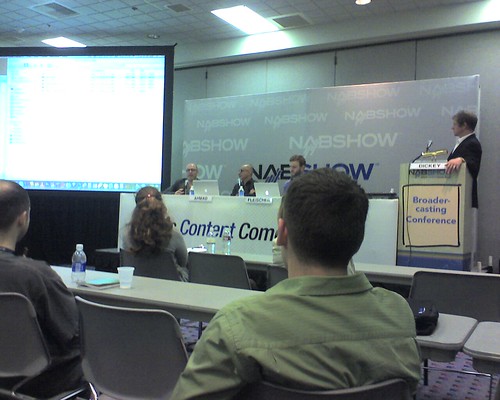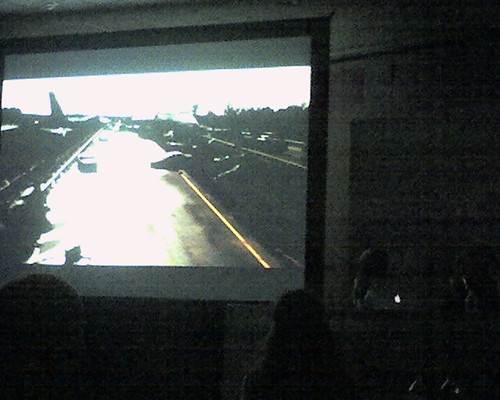How Zombieland’s Independent Approach Can Help Filmmakers Save Production Costs
Wednesday, April 14th, 2010As a part of NAB Show’s Broader-casting sessions was the panel “Big Idea, Small Budget: ‘Zombieland’s’ Production Innovations”, produced in association with Film Independent.

Digital technologies are providing filmmakers many more opportunities to create larger scale blockbusters on a much lower budget. Since we discuss digital filmmaking here on this blog, this panel was right up my alley!
Moderated by Josh Dickey, Deputy Editor of The Wrap, this panel was composed of Panelists:
Maher Ahmad, Production Designer, Zombieland
Michael Bonvillain, Cinematographer, Zombieland (not present)
Paul Linden, FX Supervisor, Zombieland
Ruben Fleischer, Director, Zombieland
To start off, the budget of this film was $21 million dollars. This is actually small for “Hollywood” films so consider that these cost-saving ideas are scalable and can apply equally to micro-budget, no-budget or mega-budget films.
There were basically four points that were covered with regard to “How exactly did you save money in production?”
Ruben Fleischer explained that he came from a low budget background (the first point) and from music video production and that producing Zombieland was a make-break moment for his career. The low budget background enabled him to approach the process with that type of mentality. Being given a hard cost budget to make his film, he had to juggle every cost involved along the way.
To Fleischer’s credit, he assembled a first-rate crew, industry veterans who not only had the experience to get the best quality but who also were smart enough to be able to work within a variety of budgets. This was an area in which he didn’t skimp on the budget. As Maher Ahmad added, “It can cost you a lot more in the end if you ‘try to save a few dollars’ on your management’s salaries”. He mentioned that some advice from his dad that helped him and that was to not be the “smartest” guy on the production and so he hired people “smarter” than him. He also said, “You have one job and that is to choose”. There are many choices brought to you by members of your team and you choose. You are the filter.
During the Q & A portion of the panel, he was asked how did you balance “letting the creative people alone to do their jobs, while still maintaining your own creative vision for the movie?” He said that part of the professionalism of the heads of his crew was the fact that they all worked within his creative vision for the film. Working with good people will help any production save money.
Tax incentives were another point where they saved money. It is not only important to find a suitable location but it could also be to your advantage to research what tax incentives are available in that certain state. This shouldn’t be the only deciding factor but it can be considered. Zombieland was shot in Atlanta, GA. Another sub-point here, a “smaller” community can really be excited for you to film in their area. Fleischer said that they were able to film in the mansion in the movie at a very low price for that very reason.
The two other points were kind of combined together in the presentation and those were “knowing the movie” and “preparation”. Preparation included, storyboards, previz, production design, VFX (which included 747-matte enhancements and digital squibs), greenscreen driving, shooting smart and quick and digital filmmaking.
Michael Bonvillain shot the movie in HD on the Genesis camera. The Genesis camera was good w/low light and there was a huge savings in having footage immediately vs. film development costs. Short comings were that the DIT tech does takes time and pulls away from the focus of the shot, discussing options but overall the shooting is faster. Also, blowups are great vs. film, not as grainy when blowing up a portion of the frame for a shot.
Paul Linden described the various VFX processes and the use of digital squibs vs. practical squibs. The decision was made pretty early on to go with digital blood spatter, not only because of the sometime misfiring of real squibs (blood packs that explode out), causing wasted time in retakes, but also that they could create any effect they wanted. They showed some examples of how they were put in and also how they could shoot, say some zombie getting their head smashed with a shovel or some other large object and that they could just shoot it with a shortened handle and VFX in the end of the implement and the resultant harm.
While some things seem extraordinarily expensive, like the giant indian statue in one scene cost $10,000 to make, they explained that that was cheaper than some other alternatives. (I don’t know about that but okay!)

Also, 150 smashed cars were used in the film. It’s cheaper to buy already smashed and crashed cars and move them around as you want them then it is to smash up good cars!
All in all, Ruben Fleischer was proud to announce that they came in $2,300 under budget!
A mention was made that with the newer, lower cost acquisition tools that are available to anyone these days, that there is no reason that these points can be applied to filmmaking at any budget.
This was the focus of another panel, I also attended, The Twenty-First Century Camera Crew and How it Works. I will discuss that session in my next post.
